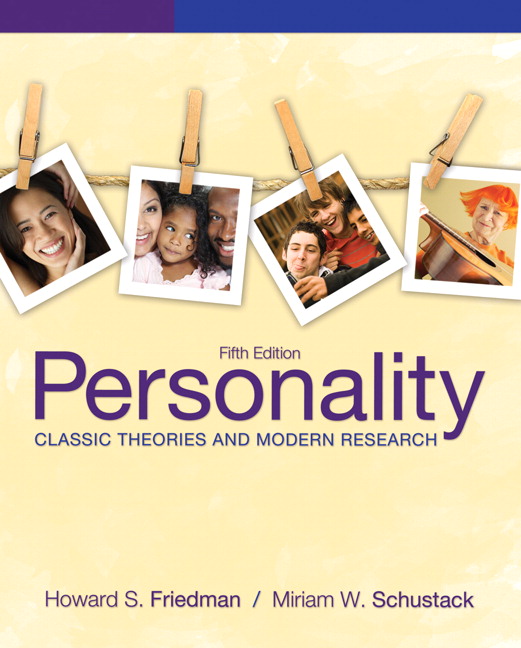Test Bank for Personality Classic Theories and Modern Research 5th Edition by Friedman
$35.00 Original price was: $35.00.$26.50Current price is: $26.50.
Test Bank for Personality Classic Theories and Modern Research 5th Edition by Friedman
This is completed downloadable of Test Bank for Personality Classic Theories and Modern Research 5th Edition by Friedman

Product Details:
- ISBN-10 : 0205050174
- ISBN-13 : 978-0205050178
- Author: Howard S. Friedman, Miriam W. Schustack
This successful text puts “personality” back into the personality course, integrating the classic insights of the personality theorists with modern research in a manner that will fascinate and encourage deeper thought.
This text explores classic theory from a perspective that encourages critical thinking and fosters intellectual insight with respect to human nature. For example, it shows the relevance of classic theory to topics of personality and culture, evolution, ego, gender, and person-situation interactionism.
Employing the highest scientific standards, Personality also uses a wide range of unique and provocative pedagogical devices that have been shown to motivate students. Hailed as the best-written, most relevant personality textbook on the market, Friedman and Schustack’s fourth edition brings the field of personality to today’s diverse student body.
Table of Content:
- About the Authors
- 1 What Is Personality?
- 1.1: Personality and Science
- 1.1.1: Where Do Personality Theories Come From?
- 1.2: Preview of the Perspectives
- 1.2.1: Overview of the Eight Perspectives
- 1.2.2: Are Personality Aspects Really Separable?
- 1.3: A Brief History of Personality Psychology
- 1.3.1: Theater and Self-Presentation
- 1.3.2: Religion
- 1.3.3: Evolutionary Biology
- 1.3.4: Testing
- 1.3.5: Modern Theory
- 1.4: The Unconscious, the Self, Uniqueness, Gender, Situations, and Culture
- 1.4.1: Is Personality a Useful Concept?
- 1.5: Personality in Context
- Conclusion: What Is Personality?
- 2 How Is Personality Studied and Assessed?
- 2.1: Measuring Personality
- 2.1.1: Reliability
- 2.1.2: Construct Validity
- 2.2: Bias
- 2.2.1: Response Sets
- 2.3: Varieties of Personality Measures
- 2.3.1: Self-Report Tests
- 2.3.2: Q-Sort Tests
- 2.3.3: Ratings and Judgments by Others
- 2.3.4: Biological Measures
- 2.3.5: Behavioral Observations
- 2.3.6: Interviews
- 2.3.7: Expressive Behavior
- 2.3.8: Document Analysis and Biographical Studies
- 2.3.9: Projective Tests
- 2.3.10: Demographics and Lifestyle
- 2.3.11: Online Internet Analysis of Social Media and Big Data
- 2.3.12: Is There One Best Method of Assessment?
- 2.4: How Not to Test Personality
- 2.5: The Design of Research
- 2.5.1: Case Studies
- 2.5.2: Correlational Studies
- 2.5.3: Experimental Studies
- 2.6: The Ethics of Personality Testing
- Conclusion: How Is Personality Studied and Assessed?
- 3 Psychoanalytic Aspects of Personality
- 3.1: Basic Psychoanalytic Concepts
- 3.1.1: The Unconscious and Therapeutic Techniques
- 3.1.2: The Structure of the Mind
- 3.2: Psychosexual Development
- 3.2.1: Oral Stage
- 3.2.2: Anal Stage
- 3.2.3: Phallic Stage
- 3.2.4: Latency Period
- 3.2.5: Genital Stage
- 3.3: Male Versus Female
- 3.4: Defense Mechanisms
- 3.4.1: Repression
- 3.4.2: Reaction Formation
- 3.4.3: Denial
- 3.4.4: Projection
- 3.4.5: Displacement
- 3.4.6: Sublimation
- 3.4.7: Regression
- 3.4.8: Rationalization
- 3.5: Cross-Cultural Issues
- 3.6: Major Contributions and Limitations of Freudian Psychoanalysis
- 3.7: Modern Developments from Experimental Psychology
- 3.7.1: Unconscious Emotion and Motivation
- 3.7.2: Illusion of Free Will
- 3.7.3: Hypermnesia
- 3.7.4: Infantile Amnesia
- 3.7.5: Memory
- 3.7.6: Amnesia
- Conclusion: Psychoanalytic Aspects of Personality
- 4 Neo-Analytic and Ego Aspects of Personality
- 4.1: Carl G. Jung and Selfhood
- 4.1.1: Background to Jung’s Approach
- 4.1.2: Jung’s Analytic Psychology
- 4.2: Alfred Adler
- 4.2.1: Adler’s Differences with Freudian Theory
- 4.2.2: Adler’s Individual Psychology
- 4.3: Karen Horney-Culture and Feminism
- 4.3.1: Rejection of Penis Envy
- 4.3.2: Basic Anxiety
- 4.3.3: The Self
- 4.3.4: Neurotic Coping Strategies
- 4.3.5: Horney’s Impact on Psychoanalytic Thinking
- 4.4: Anna Freud and Heinz Hartmann
- 4.5: Object Relations Theories
- 4.5.1: Margaret Mahler and Symbiosis
- 4.5.2: Melanie Klein, Heinz Kohut, and the Relational Perspective
- 4.5.3: The Contributions of Object Relations Approaches
- 4.6: Erik Erikson-Life-Span Identity and Identity Crises
- 4.6.1: Erikson’s Life Path
- 4.6.2: Identity Formation and Ego Crises
- 4.7: Modern Approaches to Identity
- 4.7.1: Personal and Social Identity
- 4.7.2: The Role of Goals and Life Tasks
- 4.7.3: Possible Selves and the Search for a Meaningful Life
- Conclusion: Neo-Analytic and Ego Aspects of Personality
- 5 Biological Aspects of Personality
- 5.1: Direct Genetic Effects
- 5.1.1: Natural Selection and Functionalism
- 5.1.2: Angelman Syndrome
- 5.1.3: Behavioral Genomics
- 5.2: Genetic Effects through Temperament
- 5.2.1: Activity, Emotionality, Sociability, Impulsivity
- 5.2.2: Eysenck’s Model of Nervous System Temperament
- 5.2.3: Gray’s Reinforcement Sensitivity Theory
- 5.2.4: Sensation Seeking and Addiction-Proneness
- 5.3: Twins as a Source of Data
- 5.3.1: Sir Francis Galton
- 5.3.2: Minnesota Twin Study
- 5.3.3: Nurture and Nonshared Environmental Variance
- 5.3.4: Epigenetics
- 5.3.5: Schizophrenia, Bipolar Disorder, Depression
- 5.4: Sexual Identity and Sexual Orientation
- 5.4.1: Reproductive Advantage
- 5.4.2: Hormones and Experience
- 5.5: Mediated Effects of Biology
- 5.5.1: Effects through Environmental Toxins
- 5.5.2: Effects through Physical Illness
- 5.5.3: Effects from Legal and Illegal Drugs
- 5.6: Effects from Creation of Environments
- 5.6.1: Tropisms
- 5.7: Effects from Reactions of Others
- 5.7.1: Physical Attractiveness Stereotype
- 5.8: Sociobiology
- 5.8.1: Cinderella Effect
- 5.9: Darwinism and Social Darwinism
- 5.9.1: Culture, Nazis, and “Superior Races”
- 5.9.2: The Human Genome and Eugenics
- Conclusion: Biological Aspects of Personality
- 6 Behaviorist and Learning Aspects of Personality
- 6.1: The Classical Conditioning of Personality
- 6.1.1: Conditioning a Response to a Stimulus
- 6.1.2: Behavioral Patterns as a Result of Conditioning
- 6.1.3: Extinction Processes
- 6.1.4: Conditioning of Neurotic Behavior
- 6.1.5: Complexities in Application of Conditioning Principles
- 6.2: The Origins of Behaviorist Approaches
- 6.2.1: The Rejection of Introspection
- 6.2.2: Conditioned Fear and Systematic Desensitization
- 6.3: The Radical Behaviorism of B. F. Skinner
- 6.3.1: Operant Conditioning as an Alternative Description of Personality
- 6.3.2: Controlling the Reinforcement
- 6.3.3: Skinner’s Behaviorist Utopia
- 6.4: Applying Behaviorism
- 6.4.1: Internal Processes, External Causation, and Free Will
- 6.5: Other Learning Approaches to Personality
- 6.5.1: The Role of Internal Drives
- 6.5.2: Social Learning Theory: Dollard and Miller
- 6.5.3: Habit Hierarchies
- 6.5.4: Drive Conflict
- 6.5.5: Patterns of Child-Rearing and Personality
- 6.5.6: Modern Behaviorist Personality Approaches
- 6.6: Evaluation
- Conclusion: Behaviorist and Learning Aspects of Personality
- 7 Cognitive and Social-Cognitive Aspects of Personality
- 7.1: Roots of Cognitive Approaches
- 7.1.1: Roots in Gestalt Psychology
- 7.1.2: Kurt Lewin’s Field Theory
- 7.1.3: Cognitive Style Variables
- 7.2: Cognitive and Perceptual Mechanisms
- 7.2.1: Schema Theory
- 7.2.2: Categorization
- 7.2.3: Control of Attention
- 7.2.4: Individual Differences in Attention: ADHD
- 7.2.5: Cognitive Influences on Interpersonal Relationships
- 7.3: Humans as Scientists: George Kelly’s Personal Construct Theory
- 7.3.1: Individuals as Amateur Personality Theorists
- 7.3.2: The Role Construct Repertory Test
- 7.4: Social Intelligence
- 7.5: Explanatory Style as a Personality Variable
- 7.5.1: Optimism and Pessimism
- 7.5.2: Learned Helplessness and Learned Optimism
- 7.6: Julian Rotter’s Locus of Control Approach
- 7.6.1: Generalized Versus Specific Expectancies
- 7.6.2: The Role of Reinforcements and the Psychological Situation
- 7.6.3: Locus of Control
- 7.7: Albert Bandura’s Social-Cognitive Learning Theory
- 7.7.1: The Self-System
- 7.7.2: Observational Learning
- 7.7.3: Self-Efficacy
- 7.7.4: Self-Regulation Processes
- 7.8: Humans as Computers
- Conclusion: Cognitive and Social-Cognitive Aspects of Personality
- 8 Trait Aspects of Personality
- 8.1: The History of Trait Approaches
- 8.1.1: Jung’s Extroversion and Introversion
- 8.1.2: The Use of Statistics
- 8.1.3: Q-data, T-data, L-data, and the 16PF
- 8.2: Gordon Allport’s Trait Psychology
- 8.2.1: The Importance of Culture
- 8.2.2: Functional Equivalence
- 8.2.3: Common Traits
- 8.2.4: Personal Dispositions
- 8.3: A Contemporary Trait Approach: The Big Five
- 8.3.1: How Was the Big Five Model Developed?
- 8.3.2: Career Pathways and Other Important Outcomes
- 8.3.3: More Than Five? Fewer Than Five?
- 8.3.4: Eysenck’s Big Three and Related Alternatives
- 8.3.5: Evidence for Eysenck’s Approach
- 8.4: Personality Judgments
- 8.4.1: Consensus in Personality Judgments
- 8.4.2: Limits of Trait Conceptions
- 8.5: Types
- 8.6: Motives
- 8.6.1: Measuring Motivation
- 8.6.2: Motivational Approach to Traits
- 8.7: Expressive Style
- 8.7.1: Emotional Expressiveness
- 8.7.2: Dominance, Leadership, Influence
- 8.7.3: Expressiveness and Health
- Conclusion: Trait Aspects of Personality
- 9 Humanistic, Existential, and Positive Aspects of Personality
- 9.1: Existentialism
- 9.1.1: The Phenomenological View
- 9.2: Humanism
- 9.2.1: Creativity and Flow
- 9.2.2: Relations with Other People Define Our Humanness
- 9.3: Love as a Central Focus of Life: Erich Fromm
- 9.3.1: Loving as an Art
- 9.3.2: Dialectical Humanism
- 9.3.3: Evidence Supporting Fromm’s Approach? The Age of Anxiety?
- 9.4: Responsibility: Carl Rogers
- 9.4.1: Growth, Inner Control, and the Experiencing Person
- 9.4.2: Rogerian Therapy and Becoming One’s Self
- 9.5: Anxiety and Dread
- 9.5.1: Anxiety, Threat, and Powerlessness
- 9.5.2: Personal Choice
- 9.6: Self-Actualization
- 9.6.1: Early Ideas about Self-Actualization in Jung’s Work
- 9.6.2: Peak Experiences
- 9.6.3: The Internal Push for Self-Actualization
- 9.6.4: Maslow’s Hierarchy of Needs
- 9.6.5: Measuring Self-Actualization
- 9.7: Happiness and Positive Psychology
- 9.7.1: Positive Psychology
- 9.7.2: The American Paradox and Hedonic Adaptation
- 9.7.3: Flourishing and the PERMA Model
- 9.8: Further Evaluation of Existential-Humanistic Approaches
- Conclusion: Humanistic, Existential, and Positive Aspects of Personality
- 10 Person-Situation Interactionist Aspects of Personality
- 10.1: Interpersonal Psychiatry
- 10.1.1: Interpersonal Psychiatry Contrasted with Psychoanalytic Theory
- 10.1.2: Personality as a Pattern of Interpersonal Interactions
- 10.2: Motivation and Goals
- 10.2.1: The Personological System
- 10.2.2: Thema
- 10.2.3: The Narrative Approach
- 10.3: Modern Interactionist Approaches Begin
- 10.3.1: Mischel’s Critique
- 10.3.2: Mischel’s Theory
- 10.3.3: Validity of Traits
- 10.4: The Power of Situations
- 10.4.1: Trait Relevance and the “Personality” of Situations
- 10.4.2: Consistency Averaged Across Situations
- 10.4.3: Mirror Neurons
- 10.4.4: Personal Versus Social Situations
- 10.4.5: Seeking and Creating Situations
- 10.5: The Importance of Longitudinal Study
- 10.5.1: The Life-Course Approach
- 10.5.2: Readiness
- 10.6: Interactions and Development
- 10.6.1: Unpredictability of Human Behavior
- Conclusion: Person-Situation Interactionist Aspects of Personality
- 11 Male-Female Differences
- 11.1: Do Males and Females Differ?
- 11.1.1: Evidence for Gender Differences
- 11.2: A Brief History of Gender Difference in Personality
- 11.2.1: Nineteenth-Century Views
- 11.3: Biological Influences on Gender Differences
- 11.3.1: The Effects of Prenatal Sex Hormones on Gender Behavior
- 11.3.2: The Influence of Hormones During and After Puberty
- 11.4: Gender Differences in Personality from the Eight Perspectives
- 11.4.1: The Psychoanalytic Approach
- 11.4.2: The Neo-Analytic Approaches
- 11.4.3: Biological/Evolutionary Approaches
- 11.4.4: The Behaviorist Approach
- 11.4.5: The Cognitive Approach
- 11.4.6: Trait Approaches to Masculinity and Femininity
- 11.4.7: Humanistic Approaches
- 11.4.8: Interactionist Approaches
- 11.5: Cross-Cultural Studies of Gender Differences
- 11.6: Love and Sexual Behavior
- Conclusion: Male-Female Differences
- 12 Stress, Adjustment, and Health Differences
- 12.1: Disease-Prone Personalities
- 12.1.1: Health Behaviors and Healthy Environments
- 12.1.2: The Sick Role
- 12.1.3: Disease-Caused Personality Changes
- 12.1.4: Diathesis-Stress
- 12.1.5: Personality Disorders
- 12.2: Personality, Coronary-Proneness, and Other Disease
- 12.2.1: Type A Behavior Pattern and Choleric Struggle
- 12.2.2: Giving Up
- 12.2.3: Other Diseases
- 12.3: The Human Termites
- 12.3.1: Conscientiousness
- 12.3.2: Sociability
- 12.3.3: Cheerfulness
- 12.3.4: Stressed Termites
- 12.3.5: Mental Health
- 12.4: Blaming the Victim
- 12.5: The Self-Healing Personality
- 12.5.1: Control, Commitment, and Challenge
- 12.5.2: Trust and Devotion
- 12.6: The Humanistic and Existential Aspects of Understanding Self-Healing
- 12.6.1: Growth Orientation
- 12.6.2: Identity, Morality, and Purpose
- 12.6.3: Sense of Coherence
- Conclusion: Stress, Adjustment, and Health Differences
- 13 Culture, Religion, and Ethnicity
- 13.1: Group Influence
- 13.1.1: Cultural Effects
- 13.2: History of Research on Personality and Culture
- 13.2.1: Contributions from Cultural Anthropology
- 13.2.2: Emic Versus Etic Approaches
- 13.3: Collectivist and Individualistic
- 13.4: Errors of Scientific Inference
- 13.4.1: Race as a Flawed Approach to Grouping People
- 13.4.2: The American Dilemma
- 13.5: Religion
- 13.6: Socioeconomic Influences on Personality
- 13.6.1: Karl Marx and Alienation
- 13.7: Language as a Cultural Influence
- 13.7.1: Language and Identity
- 13.7.2: Creating a Culture through Shared Language
- 13.7.3: Language as Politics
- 13.7.4: Language and Thought
- 13.7.5: Bilingualism
- 13.7.6: Language and Social Interaction
- 13.7.7: Gender and Language
- 13.8: Culture and Testing
- 13.8.1: Culture-Free and Culture-Fair Tests
- 13.8.2: Stereotype Threat
- 13.9: A More General Model of Personality and Culture
- 13.9.1: Incorporating Culture into Personality Theory
- 13.9.2: Culture and Humanity
- 13.9.3: Culture and Theory
- 13.10: Recent Research Directions
- 13.10.1: The Situation May Elicit Cultural Differences
- 13.10.2: Ethnic Socialization
- Conclusion: Culture, Religion, and Ethnicity
- 14 Love and Hate
- 14.1: The Personality of Hate
- 14.1.1: Biological Explanations of Hate
- 14.1.2: Psychoanalytic Approaches to Hate
- 14.1.3: Neo-Analytic Views of Hate
- 14.1.4: Hate and Authoritarianism
- 14.1.5: The Humanistic Perspective on Hate
- 14.1.6: Hatred as a Trait
- 14.1.7: Cognitive Approaches to Hate
- 14.1.8: Learning Theory
- 14.1.9: Cultural Differences in Hatred
- 14.2: Evaluating Hate
- 14.3: The Personality of Love
- 14.3.1: Psychoanalytic Explanations for Love
- 14.3.2: Neo-Analytic Explanations for Love
- 14.3.3: Cognitive Approaches to Love
- 14.3.4: Humanistic-Existential Perspectives on Love
- 14.3.5: Cultural Differences in Love
- 14.3.6: The Trait and Interactionist Approaches
- 14.4: Love Gone Wrong
- Conclusion: Love and Hate
- 15 Where Will We Find Personality?
- 15.1: The Brave New World of Personality
- 15.1.1: Drugs and Designer Personalities
- 15.1.2: A Utopian World Versus Abuse of Reward and Punishment
- 15.1.3: Genetic Superhumans
- 15.1.4: Can I Change My Personality?
- 15.1.5: Some Applications of Personality Psychology
- 15.2: The Eight Perspectives Revisited
- 15.2.1: Is There One Correct Perspective?
- 15.2.2: Are There Exactly Eight Perspectives?
- 15.2.3: Can the Perspectives Be Merged?
- Conclusion: Where Will We Find Personality?
- Glossary
People Also Search:
personality classic theories and modern research 5th edition
modern theories of personality
Related products
Test Bank
Test Bank for Operating Systems: Internals and Design Principles, 7th Edition: William Stallings
Test Bank
Test Bank for Clinical Immunology and Serology A Laboratory Perspective, 3rd Edition: Stevens











